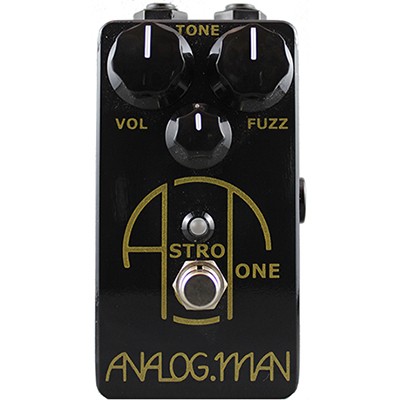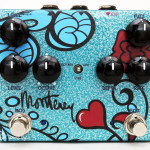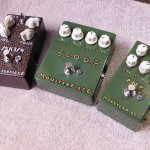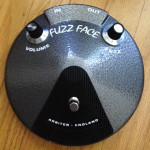Check out the recent GEARCAST show on Kyle Bull’s YouTube channel where I had a great discussion about all things related to guitar tone and music.
Tag Archives: Fuzz Face
Finding the Fuzzy Magic: Analog Man Mike Piera Mods and Demos our Fuzz Face
In the world of boutique fuzz pedal effects, Analog Man Mike Piera’s creations are among the most well-known and respected due to his attention to detail. His Sun Face fuzz is his most popular and based on the original Arbiter England Fuzz Face which was first introduced in 1966, but unlike the original which was built with a range of poorly matched components and haphazard quality control, Piera’s are built like finely tuned machines with every component being carefully measured and tested. Fuzz connoisseurs like Eric Johnson have reportedly gone through hundreds of Face Faces until finding just the right one. In any fuzz based around germanium transistors, proper matching, leakage testing, and biasing are all critical in order to get the most musical and harmonically rich fuzz.
Analog Man Astro Tone Fuzz Review: The Fuzz to Win Over the Anti-Fuzz Player
 Fuzz pedals are notoriously finicky. Not only can some fuzz boxes themselves sound different based on their own component variances and the environment or temperature they are used in, but they are always dependent on the gear that they are being used with as well. Case in point is the classic germanium Fuzz Face beloved by Hendrix. Sure, when it’s in front of a Marshall that is already overdriven, you’ll get some magic happening by adding those bits of germanium magic. But…
Fuzz pedals are notoriously finicky. Not only can some fuzz boxes themselves sound different based on their own component variances and the environment or temperature they are used in, but they are always dependent on the gear that they are being used with as well. Case in point is the classic germanium Fuzz Face beloved by Hendrix. Sure, when it’s in front of a Marshall that is already overdriven, you’ll get some magic happening by adding those bits of germanium magic. But…
…stick that same Fuzz Face in front of a Fender blackface amp and you’ll hear a whole different, and very ugly, side to the Fuzz Face. And turn on the bright switch on your old blackface and you’ll be pummeled with an even more horrid and brittle sound.
Continue reading
Keeley Monterey Rotary Fuzz Vibe Pedal Review
 Arriving in a suave black velvet bag, the latest offering from effects Guru Robert Keeley, the Keeley Monterey Rotary Fuzz Vibe pedal strikes with immediate eye appeal adorned with its groovy painted enclosure, very reminiscent of the painted guitar Hendrix sacrificed at the pedal’s namesake festival in 1967. It’s a very appealing aesthetic, very ’67 and still contemporary enough to look great on a modern pedalboard.
Arriving in a suave black velvet bag, the latest offering from effects Guru Robert Keeley, the Keeley Monterey Rotary Fuzz Vibe pedal strikes with immediate eye appeal adorned with its groovy painted enclosure, very reminiscent of the painted guitar Hendrix sacrificed at the pedal’s namesake festival in 1967. It’s a very appealing aesthetic, very ’67 and still contemporary enough to look great on a modern pedalboard.
Continue reading
Last Boutique Builder Standing: Richard Coibion of Monsterpiece Fuzz
Richard Coibion was hit by the effects building bug back in 2001. With a background  and education in electronics engineering and having a steady career in IT, Coibion dabbled in modifying fuzz circuits and tuned them to his liking. He hadn’t ever considered making a career out of building effects however.
and education in electronics engineering and having a steady career in IT, Coibion dabbled in modifying fuzz circuits and tuned them to his liking. He hadn’t ever considered making a career out of building effects however.
Continue reading
Sonus Pedals Fuzz Face 1966 Replica Reviewed
It has been some time since we wrote our Fuzz Feast series about both vintage and  recent fuzz options on the market. After seeing the prices of original fuzz units climb, I wondered what the boutique market now had available in 2015 as far as the most accurate of Fuzz Face clones. During my search, I stumbled across Sonus Pedals based in the Netherlands and its Fuzz Face 1966 replica.
recent fuzz options on the market. After seeing the prices of original fuzz units climb, I wondered what the boutique market now had available in 2015 as far as the most accurate of Fuzz Face clones. During my search, I stumbled across Sonus Pedals based in the Netherlands and its Fuzz Face 1966 replica.
Continue reading
Fuzz Feast Part 2 – An Assortment of Today’s Fuzzes
In part one, we spent some time with some vintage fuzz classics. Now let’s move forward in time and take a look at some Fuzzes that are currently on the market (with the exception of one which we’ll get to).
Fuzz, more than any other effect, really comes down to personal preferences. As a result, there is no judgment here with regards to what is the “better” fuzz unit – Just sonic descriptions and details that can help you make some choices depending on the direction that you’d like to go with your fuzz tones.
Fuzz Feast Part 1 – An Examination of Vintage Fuzz Boxes
I have a confession. As a guitarist for well over 25 years, I had always been an “anti-fuzz” person. In fact, I can honestly say I hated and despised the sound of fuzzes that I had heard. I couldn’t understand the point of purposefully making a guitar sound as atrocious and “lo-fi” as possible in mind. A fuzz tone after all, sounded nothing like an electric guitar should.
During this period of time, my search for the epitome of rock tone had to do with capturing rock guitar tones from the likes of players like Angus Young of AC/DC and of course Edward Van Halen. In my mind, any tone that deviated from those was simply bad tone, or at best, “sub-par.”
Continue reading